Importance of Financial Motivational Techniques: Three Theories of Motivation
VerifiedAdded on 2023/06/04
|13
|2732
|473
AI Summary
This essay discusses three different motivational theories and their application in business organizations. The theories analyzed are Bernard Weiner’s attribution theory, McClelland’s need theory of motivation, and BF Skinner’s reinforcement theory.
Contribute Materials
Your contribution can guide someone’s learning journey. Share your
documents today.

IMPORTANCE OF FINANCIAL MOTIVATIONAL TECHNIQUES
Essay: Three theories of motivation
Name
Date
In today’s business scenario, organizations strive harder in keeping their employees motivated
throughdifferent techniques, so as to maintain an increased level of productivity.Motivation of
employees not only encourage employee to work hard and achieve goals, but good techniques of
motivation attracts skillful and experienced workforce from the market.(De Sousa Sabbagha,
Ledimo& Martins, 2018)The managerial staff is entrusted with the responsibility of keeping the
employees motivated. There have been many motivational theories since no one theory can
explains all aspects of people's motives. In the essay below three different theories have been
analyzed how they revolve around the employees and anoverview of application of these theories
by the managers in various business organizations is also discussed.
Motivational Theories
Bernard Weiner’s was a psychologist who came up with the three dimensional Theory of
attribution .Attribution means making a sense to the other persons or to our own behavior at a
particular situation. (Weiner, 2018). It basically is based on idea of perceiving the information
and getting on to the conclusion about the events happening around the people. As per the theory
people around us try to make out how we do and what we do and the reasons that we attribute to
them effects our behavior in future. For example an employee who failed to achieve his targets
could attribute his failure to various factors, and these factors play an important role in the
motivation of employee in future so that he does not fail again due to the occurrence of the same
events that attributed to his failure. Weiner characterized attributions that affect motivation in
three steps. (Mitchell, 2013).
Stability
Essay: Three theories of motivation
Name
Date
In today’s business scenario, organizations strive harder in keeping their employees motivated
throughdifferent techniques, so as to maintain an increased level of productivity.Motivation of
employees not only encourage employee to work hard and achieve goals, but good techniques of
motivation attracts skillful and experienced workforce from the market.(De Sousa Sabbagha,
Ledimo& Martins, 2018)The managerial staff is entrusted with the responsibility of keeping the
employees motivated. There have been many motivational theories since no one theory can
explains all aspects of people's motives. In the essay below three different theories have been
analyzed how they revolve around the employees and anoverview of application of these theories
by the managers in various business organizations is also discussed.
Motivational Theories
Bernard Weiner’s was a psychologist who came up with the three dimensional Theory of
attribution .Attribution means making a sense to the other persons or to our own behavior at a
particular situation. (Weiner, 2018). It basically is based on idea of perceiving the information
and getting on to the conclusion about the events happening around the people. As per the theory
people around us try to make out how we do and what we do and the reasons that we attribute to
them effects our behavior in future. For example an employee who failed to achieve his targets
could attribute his failure to various factors, and these factors play an important role in the
motivation of employee in future so that he does not fail again due to the occurrence of the same
events that attributed to his failure. Weiner characterized attributions that affect motivation in
three steps. (Mitchell, 2013).
Stability
Secure Best Marks with AI Grader
Need help grading? Try our AI Grader for instant feedback on your assignments.
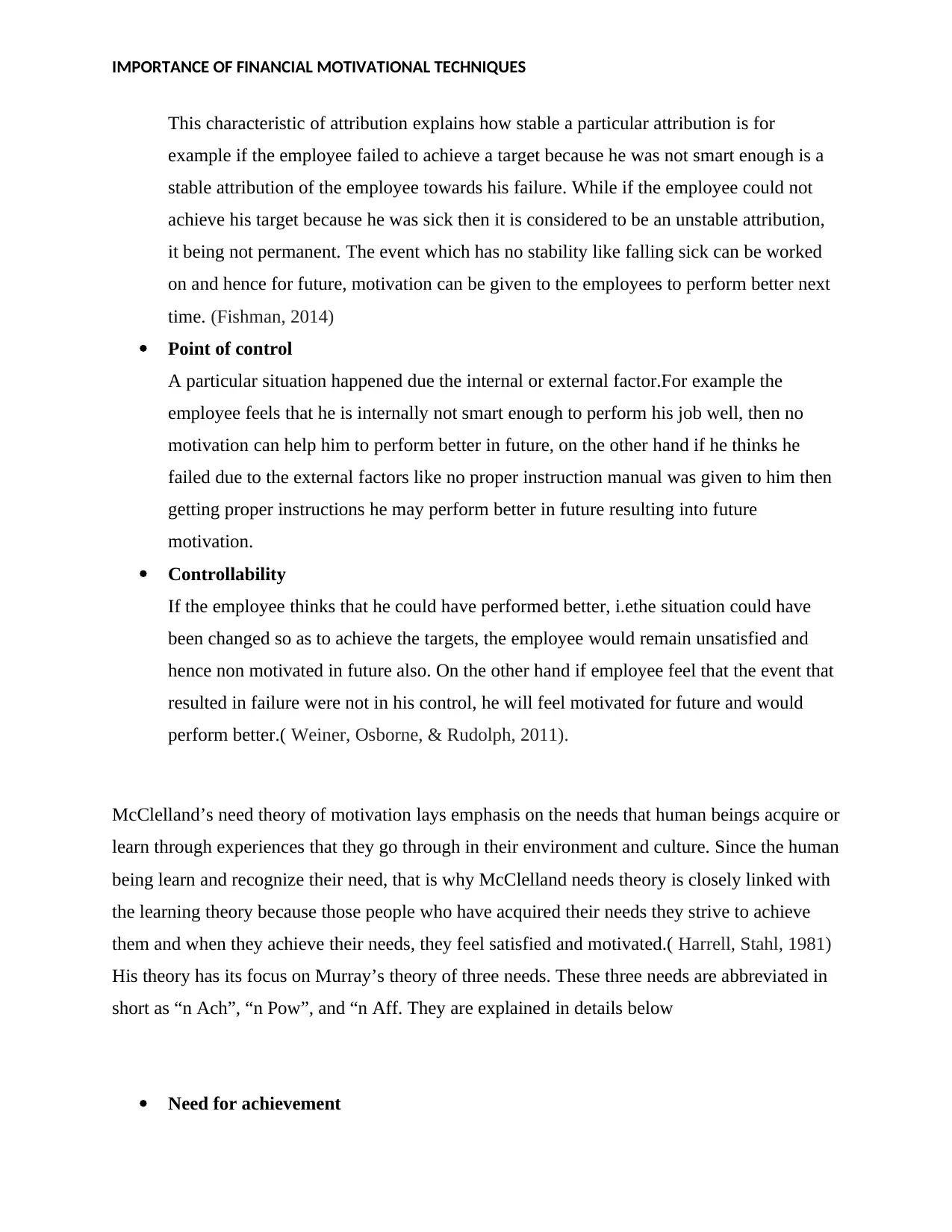
IMPORTANCE OF FINANCIAL MOTIVATIONAL TECHNIQUES
This characteristic of attribution explains how stable a particular attribution is for
example if the employee failed to achieve a target because he was not smart enough is a
stable attribution of the employee towards his failure. While if the employee could not
achieve his target because he was sick then it is considered to be an unstable attribution,
it being not permanent. The event which has no stability like falling sick can be worked
on and hence for future, motivation can be given to the employees to perform better next
time. (Fishman, 2014)
Point of control
A particular situation happened due the internal or external factor.For example the
employee feels that he is internally not smart enough to perform his job well, then no
motivation can help him to perform better in future, on the other hand if he thinks he
failed due to the external factors like no proper instruction manual was given to him then
getting proper instructions he may perform better in future resulting into future
motivation.
Controllability
If the employee thinks that he could have performed better, i.ethe situation could have
been changed so as to achieve the targets, the employee would remain unsatisfied and
hence non motivated in future also. On the other hand if employee feel that the event that
resulted in failure were not in his control, he will feel motivated for future and would
perform better.( Weiner, Osborne, & Rudolph, 2011).
McClelland’s need theory of motivation lays emphasis on the needs that human beings acquire or
learn through experiences that they go through in their environment and culture. Since the human
being learn and recognize their need, that is why McClelland needs theory is closely linked with
the learning theory because those people who have acquired their needs they strive to achieve
them and when they achieve their needs, they feel satisfied and motivated.( Harrell, Stahl, 1981)
His theory has its focus on Murray’s theory of three needs. These three needs are abbreviated in
short as “n Ach”, “n Pow”, and “n Aff. They are explained in details below
Need for achievement
This characteristic of attribution explains how stable a particular attribution is for
example if the employee failed to achieve a target because he was not smart enough is a
stable attribution of the employee towards his failure. While if the employee could not
achieve his target because he was sick then it is considered to be an unstable attribution,
it being not permanent. The event which has no stability like falling sick can be worked
on and hence for future, motivation can be given to the employees to perform better next
time. (Fishman, 2014)
Point of control
A particular situation happened due the internal or external factor.For example the
employee feels that he is internally not smart enough to perform his job well, then no
motivation can help him to perform better in future, on the other hand if he thinks he
failed due to the external factors like no proper instruction manual was given to him then
getting proper instructions he may perform better in future resulting into future
motivation.
Controllability
If the employee thinks that he could have performed better, i.ethe situation could have
been changed so as to achieve the targets, the employee would remain unsatisfied and
hence non motivated in future also. On the other hand if employee feel that the event that
resulted in failure were not in his control, he will feel motivated for future and would
perform better.( Weiner, Osborne, & Rudolph, 2011).
McClelland’s need theory of motivation lays emphasis on the needs that human beings acquire or
learn through experiences that they go through in their environment and culture. Since the human
being learn and recognize their need, that is why McClelland needs theory is closely linked with
the learning theory because those people who have acquired their needs they strive to achieve
them and when they achieve their needs, they feel satisfied and motivated.( Harrell, Stahl, 1981)
His theory has its focus on Murray’s theory of three needs. These three needs are abbreviated in
short as “n Ach”, “n Pow”, and “n Aff. They are explained in details below
Need for achievement
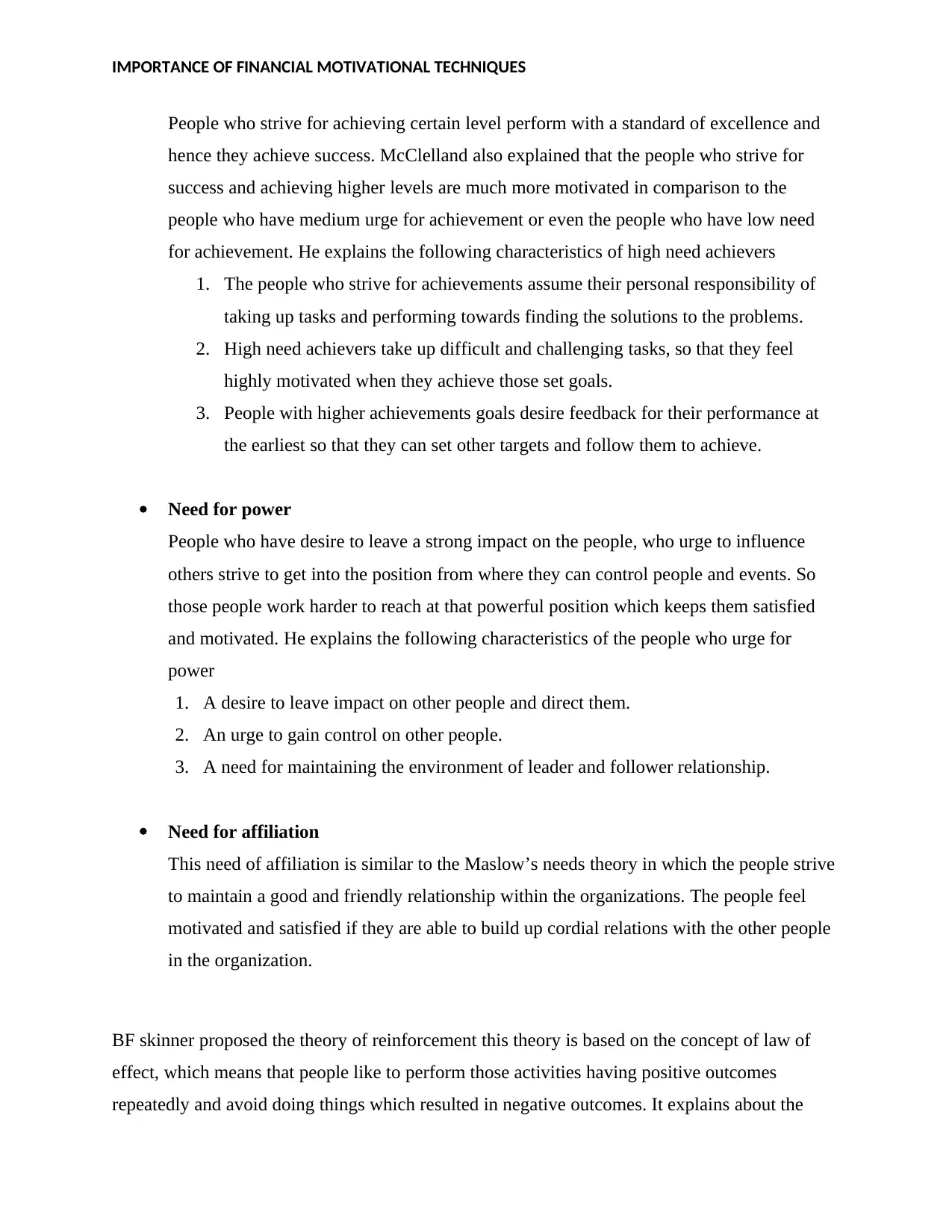
IMPORTANCE OF FINANCIAL MOTIVATIONAL TECHNIQUES
People who strive for achieving certain level perform with a standard of excellence and
hence they achieve success. McClelland also explained that the people who strive for
success and achieving higher levels are much more motivated in comparison to the
people who have medium urge for achievement or even the people who have low need
for achievement. He explains the following characteristics of high need achievers
1. The people who strive for achievements assume their personal responsibility of
taking up tasks and performing towards finding the solutions to the problems.
2. High need achievers take up difficult and challenging tasks, so that they feel
highly motivated when they achieve those set goals.
3. People with higher achievements goals desire feedback for their performance at
the earliest so that they can set other targets and follow them to achieve.
Need for power
People who have desire to leave a strong impact on the people, who urge to influence
others strive to get into the position from where they can control people and events. So
those people work harder to reach at that powerful position which keeps them satisfied
and motivated. He explains the following characteristics of the people who urge for
power
1. A desire to leave impact on other people and direct them.
2. An urge to gain control on other people.
3. A need for maintaining the environment of leader and follower relationship.
Need for affiliation
This need of affiliation is similar to the Maslow’s needs theory in which the people strive
to maintain a good and friendly relationship within the organizations. The people feel
motivated and satisfied if they are able to build up cordial relations with the other people
in the organization.
BF skinner proposed the theory of reinforcement this theory is based on the concept of law of
effect, which means that people like to perform those activities having positive outcomes
repeatedly and avoid doing things which resulted in negative outcomes. It explains about the
People who strive for achieving certain level perform with a standard of excellence and
hence they achieve success. McClelland also explained that the people who strive for
success and achieving higher levels are much more motivated in comparison to the
people who have medium urge for achievement or even the people who have low need
for achievement. He explains the following characteristics of high need achievers
1. The people who strive for achievements assume their personal responsibility of
taking up tasks and performing towards finding the solutions to the problems.
2. High need achievers take up difficult and challenging tasks, so that they feel
highly motivated when they achieve those set goals.
3. People with higher achievements goals desire feedback for their performance at
the earliest so that they can set other targets and follow them to achieve.
Need for power
People who have desire to leave a strong impact on the people, who urge to influence
others strive to get into the position from where they can control people and events. So
those people work harder to reach at that powerful position which keeps them satisfied
and motivated. He explains the following characteristics of the people who urge for
power
1. A desire to leave impact on other people and direct them.
2. An urge to gain control on other people.
3. A need for maintaining the environment of leader and follower relationship.
Need for affiliation
This need of affiliation is similar to the Maslow’s needs theory in which the people strive
to maintain a good and friendly relationship within the organizations. The people feel
motivated and satisfied if they are able to build up cordial relations with the other people
in the organization.
BF skinner proposed the theory of reinforcement this theory is based on the concept of law of
effect, which means that people like to perform those activities having positive outcomes
repeatedly and avoid doing things which resulted in negative outcomes. It explains about the
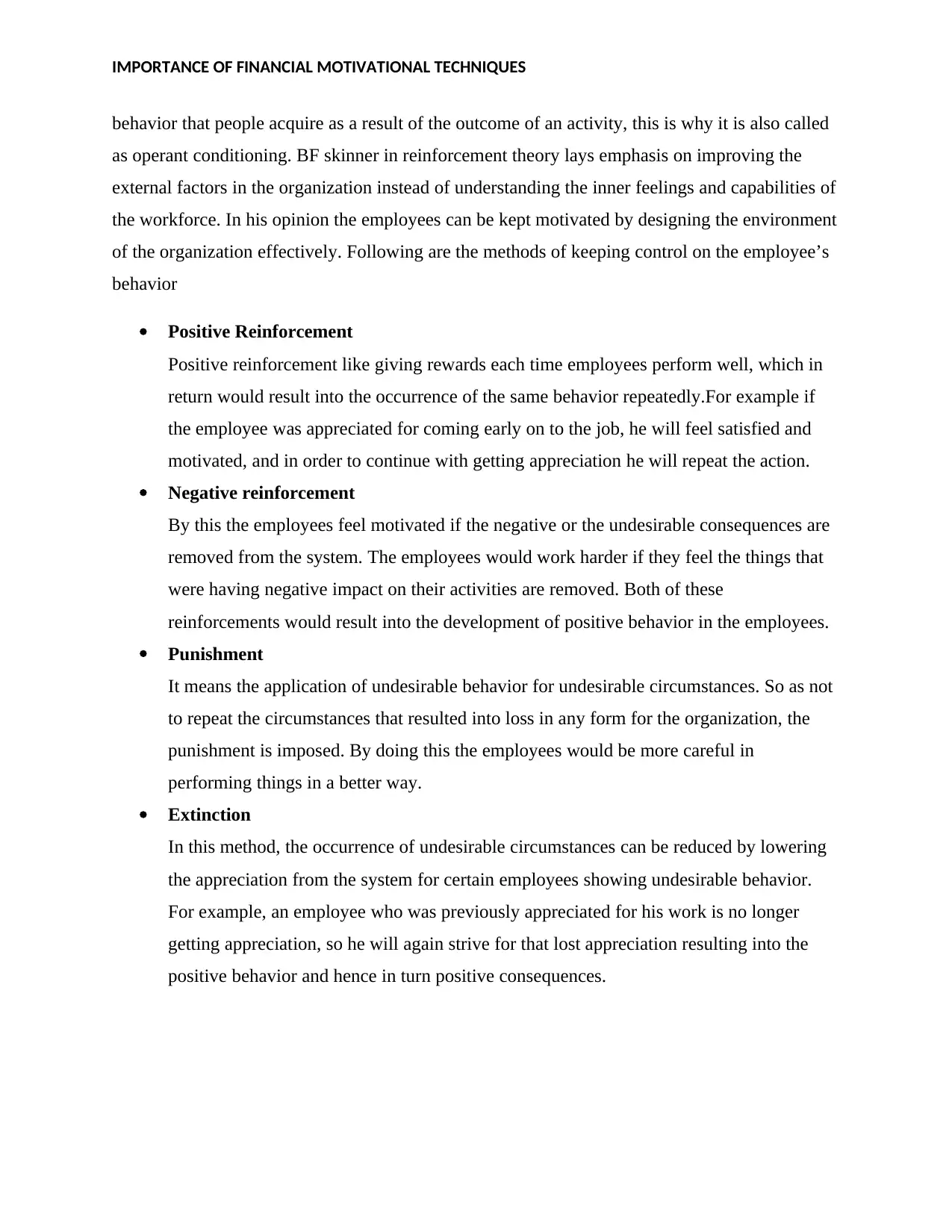
IMPORTANCE OF FINANCIAL MOTIVATIONAL TECHNIQUES
behavior that people acquire as a result of the outcome of an activity, this is why it is also called
as operant conditioning. BF skinner in reinforcement theory lays emphasis on improving the
external factors in the organization instead of understanding the inner feelings and capabilities of
the workforce. In his opinion the employees can be kept motivated by designing the environment
of the organization effectively. Following are the methods of keeping control on the employee’s
behavior
Positive Reinforcement
Positive reinforcement like giving rewards each time employees perform well, which in
return would result into the occurrence of the same behavior repeatedly.For example if
the employee was appreciated for coming early on to the job, he will feel satisfied and
motivated, and in order to continue with getting appreciation he will repeat the action.
Negative reinforcement
By this the employees feel motivated if the negative or the undesirable consequences are
removed from the system. The employees would work harder if they feel the things that
were having negative impact on their activities are removed. Both of these
reinforcements would result into the development of positive behavior in the employees.
Punishment
It means the application of undesirable behavior for undesirable circumstances. So as not
to repeat the circumstances that resulted into loss in any form for the organization, the
punishment is imposed. By doing this the employees would be more careful in
performing things in a better way.
Extinction
In this method, the occurrence of undesirable circumstances can be reduced by lowering
the appreciation from the system for certain employees showing undesirable behavior.
For example, an employee who was previously appreciated for his work is no longer
getting appreciation, so he will again strive for that lost appreciation resulting into the
positive behavior and hence in turn positive consequences.
behavior that people acquire as a result of the outcome of an activity, this is why it is also called
as operant conditioning. BF skinner in reinforcement theory lays emphasis on improving the
external factors in the organization instead of understanding the inner feelings and capabilities of
the workforce. In his opinion the employees can be kept motivated by designing the environment
of the organization effectively. Following are the methods of keeping control on the employee’s
behavior
Positive Reinforcement
Positive reinforcement like giving rewards each time employees perform well, which in
return would result into the occurrence of the same behavior repeatedly.For example if
the employee was appreciated for coming early on to the job, he will feel satisfied and
motivated, and in order to continue with getting appreciation he will repeat the action.
Negative reinforcement
By this the employees feel motivated if the negative or the undesirable consequences are
removed from the system. The employees would work harder if they feel the things that
were having negative impact on their activities are removed. Both of these
reinforcements would result into the development of positive behavior in the employees.
Punishment
It means the application of undesirable behavior for undesirable circumstances. So as not
to repeat the circumstances that resulted into loss in any form for the organization, the
punishment is imposed. By doing this the employees would be more careful in
performing things in a better way.
Extinction
In this method, the occurrence of undesirable circumstances can be reduced by lowering
the appreciation from the system for certain employees showing undesirable behavior.
For example, an employee who was previously appreciated for his work is no longer
getting appreciation, so he will again strive for that lost appreciation resulting into the
positive behavior and hence in turn positive consequences.
Secure Best Marks with AI Grader
Need help grading? Try our AI Grader for instant feedback on your assignments.
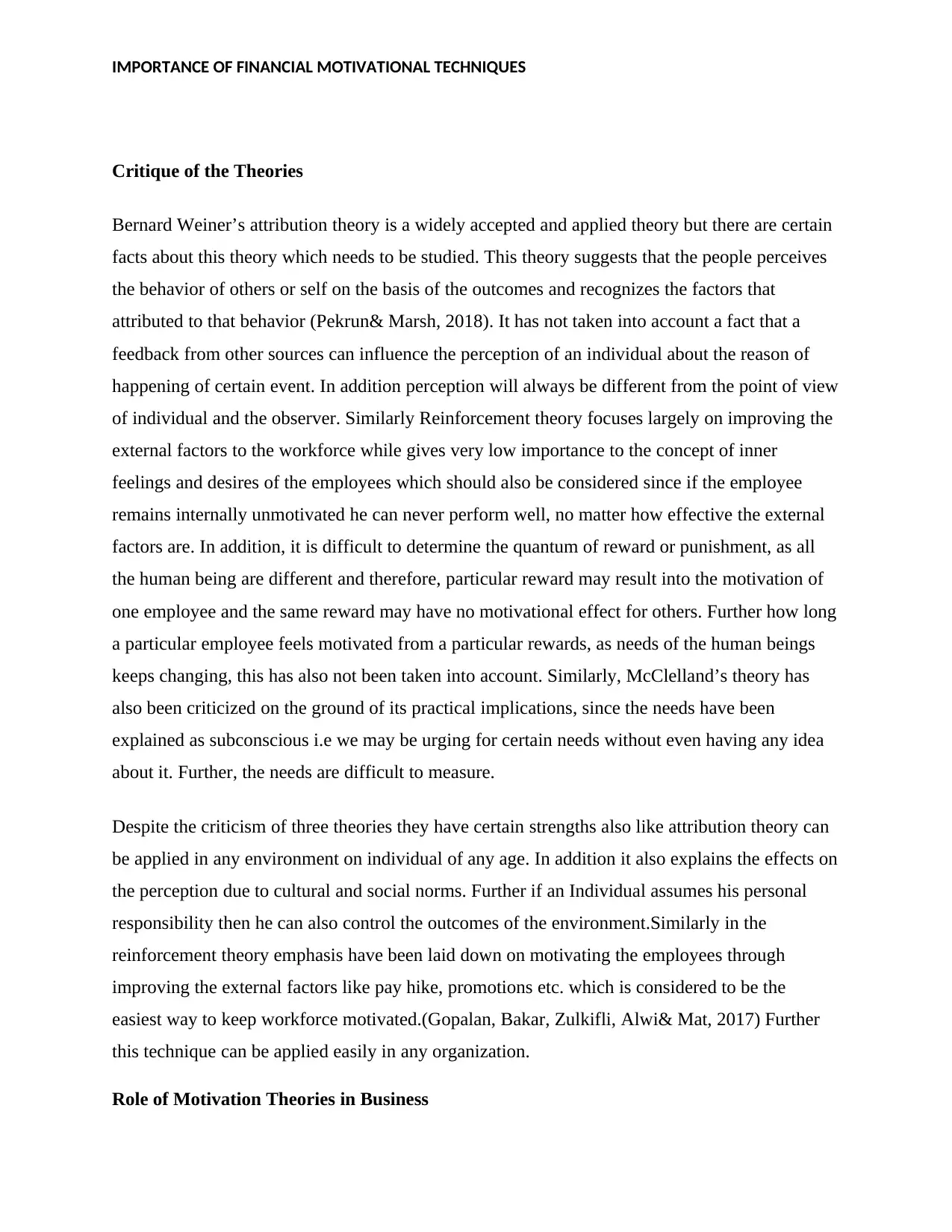
IMPORTANCE OF FINANCIAL MOTIVATIONAL TECHNIQUES
Critique of the Theories
Bernard Weiner’s attribution theory is a widely accepted and applied theory but there are certain
facts about this theory which needs to be studied. This theory suggests that the people perceives
the behavior of others or self on the basis of the outcomes and recognizes the factors that
attributed to that behavior (Pekrun& Marsh, 2018). It has not taken into account a fact that a
feedback from other sources can influence the perception of an individual about the reason of
happening of certain event. In addition perception will always be different from the point of view
of individual and the observer. Similarly Reinforcement theory focuses largely on improving the
external factors to the workforce while gives very low importance to the concept of inner
feelings and desires of the employees which should also be considered since if the employee
remains internally unmotivated he can never perform well, no matter how effective the external
factors are. In addition, it is difficult to determine the quantum of reward or punishment, as all
the human being are different and therefore, particular reward may result into the motivation of
one employee and the same reward may have no motivational effect for others. Further how long
a particular employee feels motivated from a particular rewards, as needs of the human beings
keeps changing, this has also not been taken into account. Similarly, McClelland’s theory has
also been criticized on the ground of its practical implications, since the needs have been
explained as subconscious i.e we may be urging for certain needs without even having any idea
about it. Further, the needs are difficult to measure.
Despite the criticism of three theories they have certain strengths also like attribution theory can
be applied in any environment on individual of any age. In addition it also explains the effects on
the perception due to cultural and social norms. Further if an Individual assumes his personal
responsibility then he can also control the outcomes of the environment.Similarly in the
reinforcement theory emphasis have been laid down on motivating the employees through
improving the external factors like pay hike, promotions etc. which is considered to be the
easiest way to keep workforce motivated.(Gopalan, Bakar, Zulkifli, Alwi& Mat, 2017) Further
this technique can be applied easily in any organization.
Role of Motivation Theories in Business
Critique of the Theories
Bernard Weiner’s attribution theory is a widely accepted and applied theory but there are certain
facts about this theory which needs to be studied. This theory suggests that the people perceives
the behavior of others or self on the basis of the outcomes and recognizes the factors that
attributed to that behavior (Pekrun& Marsh, 2018). It has not taken into account a fact that a
feedback from other sources can influence the perception of an individual about the reason of
happening of certain event. In addition perception will always be different from the point of view
of individual and the observer. Similarly Reinforcement theory focuses largely on improving the
external factors to the workforce while gives very low importance to the concept of inner
feelings and desires of the employees which should also be considered since if the employee
remains internally unmotivated he can never perform well, no matter how effective the external
factors are. In addition, it is difficult to determine the quantum of reward or punishment, as all
the human being are different and therefore, particular reward may result into the motivation of
one employee and the same reward may have no motivational effect for others. Further how long
a particular employee feels motivated from a particular rewards, as needs of the human beings
keeps changing, this has also not been taken into account. Similarly, McClelland’s theory has
also been criticized on the ground of its practical implications, since the needs have been
explained as subconscious i.e we may be urging for certain needs without even having any idea
about it. Further, the needs are difficult to measure.
Despite the criticism of three theories they have certain strengths also like attribution theory can
be applied in any environment on individual of any age. In addition it also explains the effects on
the perception due to cultural and social norms. Further if an Individual assumes his personal
responsibility then he can also control the outcomes of the environment.Similarly in the
reinforcement theory emphasis have been laid down on motivating the employees through
improving the external factors like pay hike, promotions etc. which is considered to be the
easiest way to keep workforce motivated.(Gopalan, Bakar, Zulkifli, Alwi& Mat, 2017) Further
this technique can be applied easily in any organization.
Role of Motivation Theories in Business

IMPORTANCE OF FINANCIAL MOTIVATIONAL TECHNIQUES
Reinforcement theory is widely applied in the workplace as a way to enhance the work
performance by decreasing the undesired behavior and hence increasing the desired behavior The
assumptions of this theory is that by modification of the behavior, the management can cope up
with the problems like absenteeism to the higher level of productivity. This can be done by
explaining and making employees understand the goals and keeping them focused on to
achieving them.
Additionally McClelland’s needs theory can also be applied by the managers by giving
authorities to the employees so that they feel powerful and work harder to achieve the goals.
Also few employees who strive for achievement can be given challenging tasks so that they feel
motivated by achieving them. Further occasional informal meets should also be kept so that the
employees feel recognized and affiliated to each other. (Badubi,2018)
Further attribution theory can be applied by the managers in the organization by ensuring to give
them feedback and encouraging them to improve (Shoraj&Llaci, 2015). The employees can be
trained in such a manner that they use different strategies to make success controllable and hence
the employees would prevent from attributing their failure to their innate incapability, rather they
would be attributing their failures if any to the controllable factors and can be improved for
better future.
Conclusion
Analyzing the motivation theories is helpful in a business organization since it assists the
managers to understand how they can develop a workforce that is productive and effective.
Bernard Weiner’s theory talks about the attribution of employee’s behavior to certain situations.
And also how can these situations which resulted in failure are controlled. however this theory
has also been criticized since this theory doesn’t give relevance to the However, the
Reinforcement theory purports to explain improving the external factors and have given low
importance to the internal factors of employees in order to motivate them due to which it has also
been criticized Lastly, McClelland’sTheory of needpurports to explain the needs that a human
being possess which can be used as a source of motivation in organization. Managers delegate
authorities, conduct unofficial meets, set challenging targets to motivate employees.
Reinforcement theory is widely applied in the workplace as a way to enhance the work
performance by decreasing the undesired behavior and hence increasing the desired behavior The
assumptions of this theory is that by modification of the behavior, the management can cope up
with the problems like absenteeism to the higher level of productivity. This can be done by
explaining and making employees understand the goals and keeping them focused on to
achieving them.
Additionally McClelland’s needs theory can also be applied by the managers by giving
authorities to the employees so that they feel powerful and work harder to achieve the goals.
Also few employees who strive for achievement can be given challenging tasks so that they feel
motivated by achieving them. Further occasional informal meets should also be kept so that the
employees feel recognized and affiliated to each other. (Badubi,2018)
Further attribution theory can be applied by the managers in the organization by ensuring to give
them feedback and encouraging them to improve (Shoraj&Llaci, 2015). The employees can be
trained in such a manner that they use different strategies to make success controllable and hence
the employees would prevent from attributing their failure to their innate incapability, rather they
would be attributing their failures if any to the controllable factors and can be improved for
better future.
Conclusion
Analyzing the motivation theories is helpful in a business organization since it assists the
managers to understand how they can develop a workforce that is productive and effective.
Bernard Weiner’s theory talks about the attribution of employee’s behavior to certain situations.
And also how can these situations which resulted in failure are controlled. however this theory
has also been criticized since this theory doesn’t give relevance to the However, the
Reinforcement theory purports to explain improving the external factors and have given low
importance to the internal factors of employees in order to motivate them due to which it has also
been criticized Lastly, McClelland’sTheory of needpurports to explain the needs that a human
being possess which can be used as a source of motivation in organization. Managers delegate
authorities, conduct unofficial meets, set challenging targets to motivate employees.
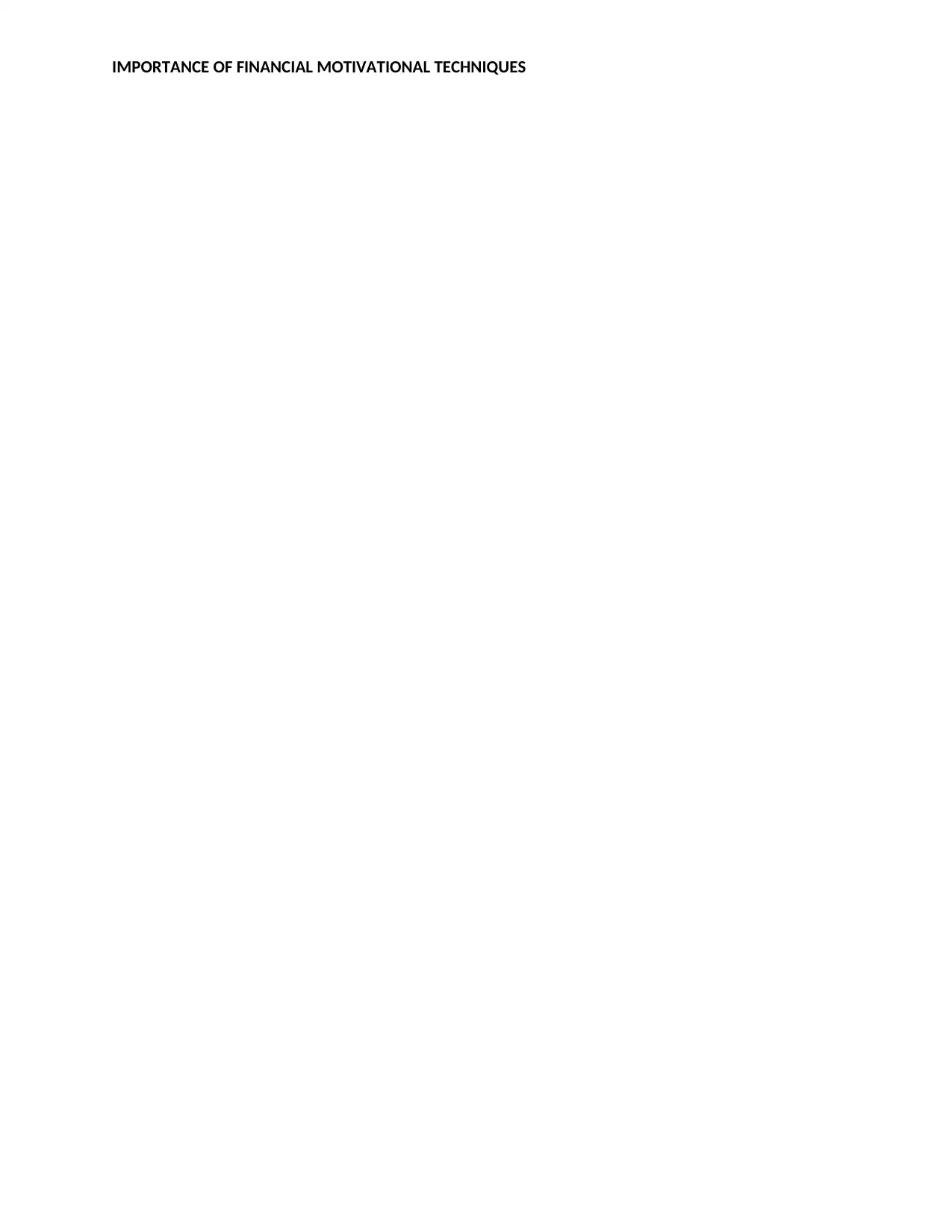
IMPORTANCE OF FINANCIAL MOTIVATIONAL TECHNIQUES
Paraphrase This Document
Need a fresh take? Get an instant paraphrase of this document with our AI Paraphraser
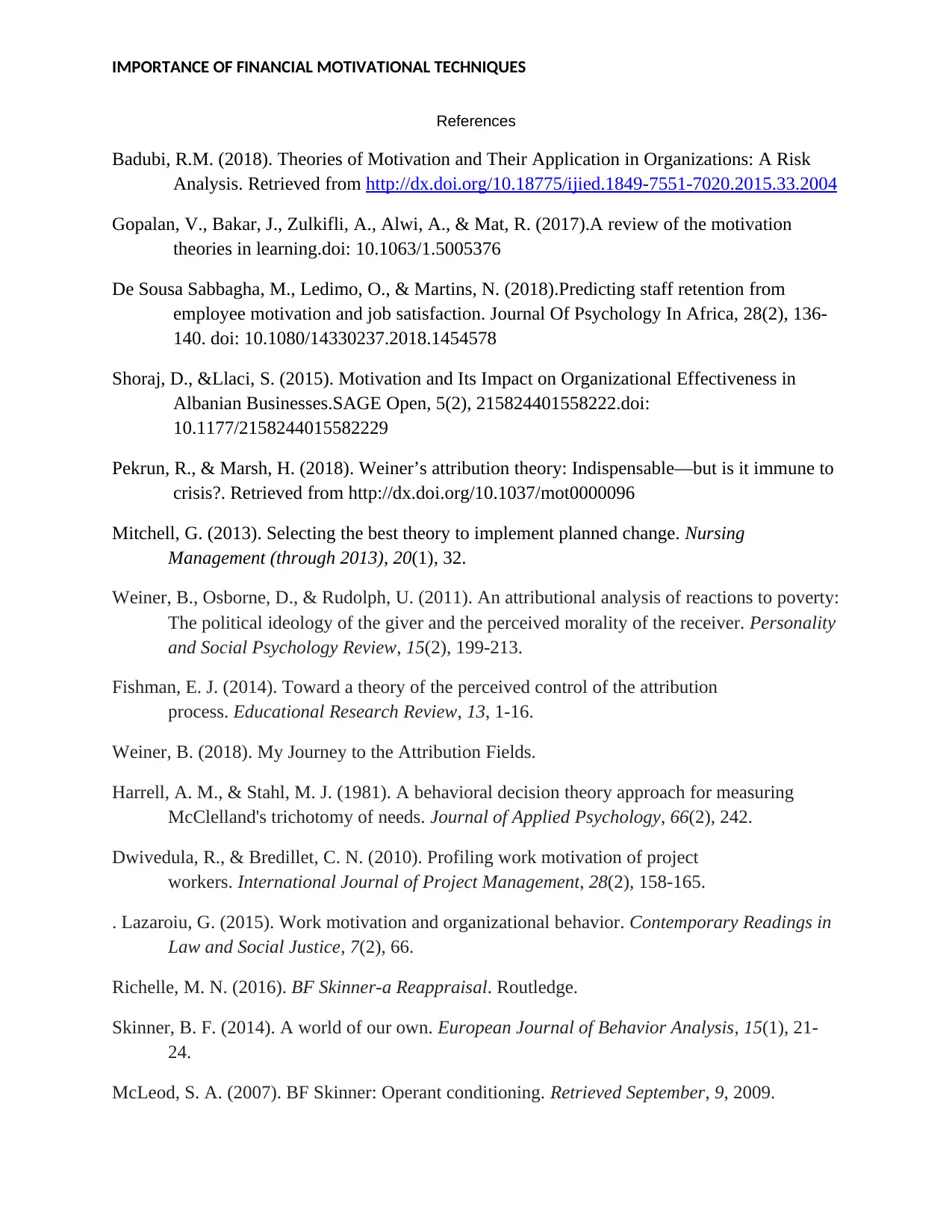
IMPORTANCE OF FINANCIAL MOTIVATIONAL TECHNIQUES
References
Badubi, R.M. (2018). Theories of Motivation and Their Application in Organizations: A Risk
Analysis. Retrieved from http://dx.doi.org/10.18775/ijied.1849-7551-7020.2015.33.2004
Gopalan, V., Bakar, J., Zulkifli, A., Alwi, A., & Mat, R. (2017).A review of the motivation
theories in learning.doi: 10.1063/1.5005376
De Sousa Sabbagha, M., Ledimo, O., & Martins, N. (2018).Predicting staff retention from
employee motivation and job satisfaction. Journal Of Psychology In Africa, 28(2), 136-
140. doi: 10.1080/14330237.2018.1454578
Shoraj, D., &Llaci, S. (2015). Motivation and Its Impact on Organizational Effectiveness in
Albanian Businesses.SAGE Open, 5(2), 215824401558222.doi:
10.1177/2158244015582229
Pekrun, R., & Marsh, H. (2018). Weiner’s attribution theory: Indispensable—but is it immune to
crisis?. Retrieved from http://dx.doi.org/10.1037/mot0000096
Mitchell, G. (2013). Selecting the best theory to implement planned change. Nursing
Management (through 2013), 20(1), 32.
Weiner, B., Osborne, D., & Rudolph, U. (2011). An attributional analysis of reactions to poverty:
The political ideology of the giver and the perceived morality of the receiver. Personality
and Social Psychology Review, 15(2), 199-213.
Fishman, E. J. (2014). Toward a theory of the perceived control of the attribution
process. Educational Research Review, 13, 1-16.
Weiner, B. (2018). My Journey to the Attribution Fields.
Harrell, A. M., & Stahl, M. J. (1981). A behavioral decision theory approach for measuring
McClelland's trichotomy of needs. Journal of Applied Psychology, 66(2), 242.
Dwivedula, R., & Bredillet, C. N. (2010). Profiling work motivation of project
workers. International Journal of Project Management, 28(2), 158-165.
. Lazaroiu, G. (2015). Work motivation and organizational behavior. Contemporary Readings in
Law and Social Justice, 7(2), 66.
Richelle, M. N. (2016). BF Skinner-a Reappraisal. Routledge.
Skinner, B. F. (2014). A world of our own. European Journal of Behavior Analysis, 15(1), 21-
24.
McLeod, S. A. (2007). BF Skinner: Operant conditioning. Retrieved September, 9, 2009.
References
Badubi, R.M. (2018). Theories of Motivation and Their Application in Organizations: A Risk
Analysis. Retrieved from http://dx.doi.org/10.18775/ijied.1849-7551-7020.2015.33.2004
Gopalan, V., Bakar, J., Zulkifli, A., Alwi, A., & Mat, R. (2017).A review of the motivation
theories in learning.doi: 10.1063/1.5005376
De Sousa Sabbagha, M., Ledimo, O., & Martins, N. (2018).Predicting staff retention from
employee motivation and job satisfaction. Journal Of Psychology In Africa, 28(2), 136-
140. doi: 10.1080/14330237.2018.1454578
Shoraj, D., &Llaci, S. (2015). Motivation and Its Impact on Organizational Effectiveness in
Albanian Businesses.SAGE Open, 5(2), 215824401558222.doi:
10.1177/2158244015582229
Pekrun, R., & Marsh, H. (2018). Weiner’s attribution theory: Indispensable—but is it immune to
crisis?. Retrieved from http://dx.doi.org/10.1037/mot0000096
Mitchell, G. (2013). Selecting the best theory to implement planned change. Nursing
Management (through 2013), 20(1), 32.
Weiner, B., Osborne, D., & Rudolph, U. (2011). An attributional analysis of reactions to poverty:
The political ideology of the giver and the perceived morality of the receiver. Personality
and Social Psychology Review, 15(2), 199-213.
Fishman, E. J. (2014). Toward a theory of the perceived control of the attribution
process. Educational Research Review, 13, 1-16.
Weiner, B. (2018). My Journey to the Attribution Fields.
Harrell, A. M., & Stahl, M. J. (1981). A behavioral decision theory approach for measuring
McClelland's trichotomy of needs. Journal of Applied Psychology, 66(2), 242.
Dwivedula, R., & Bredillet, C. N. (2010). Profiling work motivation of project
workers. International Journal of Project Management, 28(2), 158-165.
. Lazaroiu, G. (2015). Work motivation and organizational behavior. Contemporary Readings in
Law and Social Justice, 7(2), 66.
Richelle, M. N. (2016). BF Skinner-a Reappraisal. Routledge.
Skinner, B. F. (2014). A world of our own. European Journal of Behavior Analysis, 15(1), 21-
24.
McLeod, S. A. (2007). BF Skinner: Operant conditioning. Retrieved September, 9, 2009.

IMPORTANCE OF FINANCIAL MOTIVATIONAL TECHNIQUES
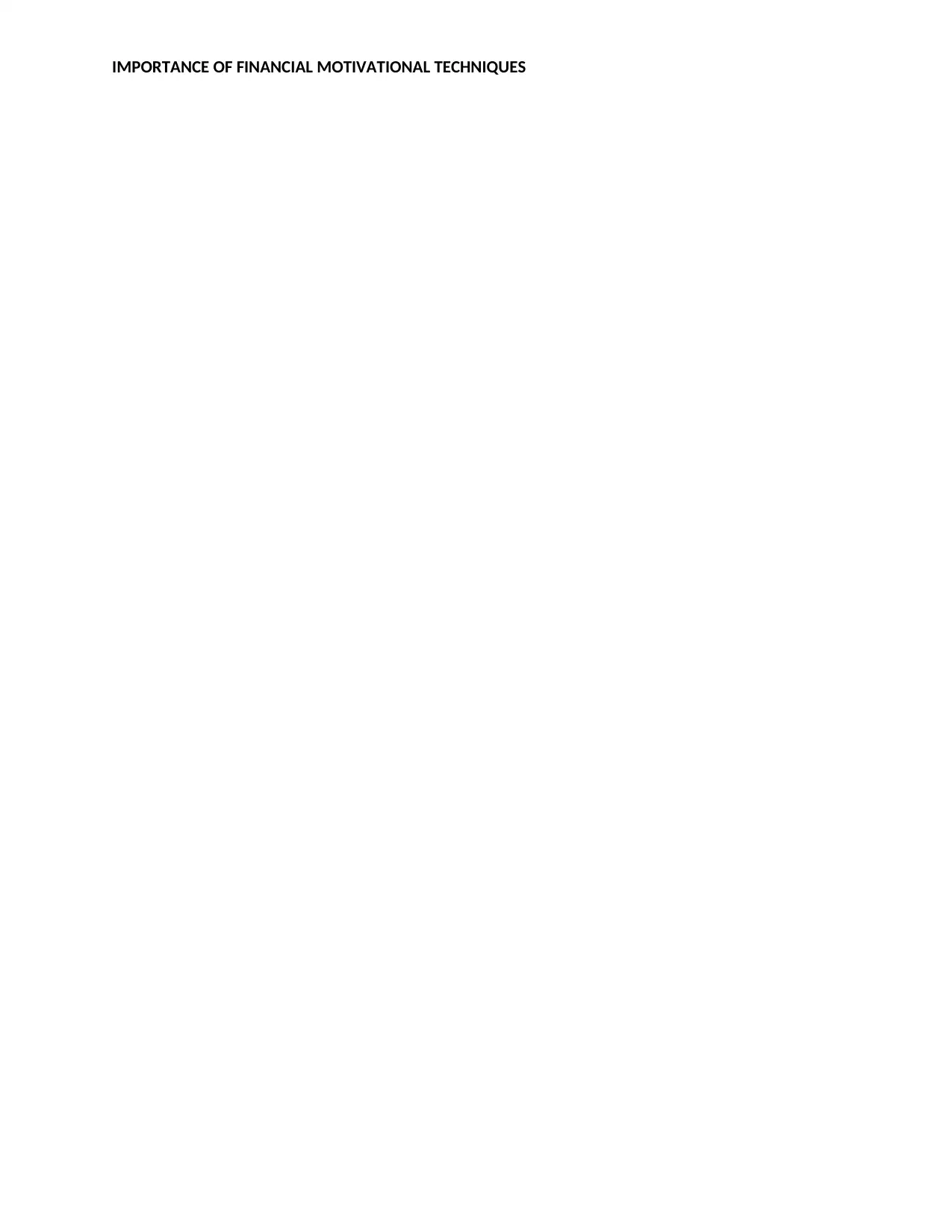
IMPORTANCE OF FINANCIAL MOTIVATIONAL TECHNIQUES
Secure Best Marks with AI Grader
Need help grading? Try our AI Grader for instant feedback on your assignments.

IMPORTANCE OF FINANCIAL MOTIVATIONAL TECHNIQUES

IMPORTANCE OF FINANCIAL MOTIVATIONAL TECHNIQUES

IMPORTANCE OF FINANCIAL MOTIVATIONAL TECHNIQUES
1 out of 13
Your All-in-One AI-Powered Toolkit for Academic Success.
+13062052269
info@desklib.com
Available 24*7 on WhatsApp / Email
![[object Object]](/_next/static/media/star-bottom.7253800d.svg)
Unlock your academic potential
© 2024 | Zucol Services PVT LTD | All rights reserved.
